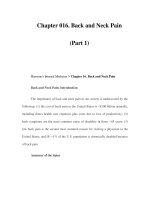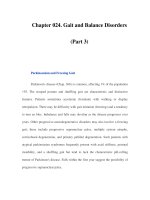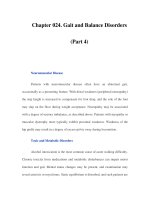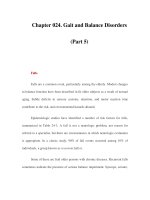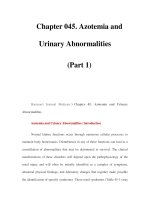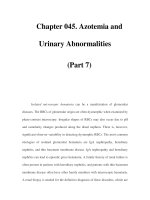Chapter 072. Malnutrition and Nutritional Assessment (Part 1) ppt
Bạn đang xem bản rút gọn của tài liệu. Xem và tải ngay bản đầy đủ của tài liệu tại đây (52.55 KB, 6 trang )
Chapter 072. Malnutrition and
Nutritional Assessment
(Part 1)
Harrison's Internal Medicine > Chapter 72. Malnutrition and Nutritional
Assessment
Malnutrition and Nutritional Assessment: Introduction
Malnutrition can arise from primary or secondary causes, with the former
resulting from inadequate or poor-quality food intake and the latter from diseases
that alter food intake or nutrient requirements, metabolism, or absorption. Primary
malnutrition occurs mainly in developing countries and under conditions of war or
famine. Secondary malnutrition, the main form encountered in industrialized
countries, was largely unrecognized until the early 1970s, when it became
appreciated that persons with adequate food supplies can become malnourished as
a result of acute or chronic diseases that alter nutrient intake or metabolism.
Various studies have shown that protein-energy malnutrition (PEM) affects one-
third to one-half of patients on general medical and surgical wards in teaching
hospitals. The consistent finding that nutritional status influences patient prognosis
underscores the importance of preventing, detecting, and treating malnutrition.
Protein-Energy Malnutrition
The two major types of PEM are marasmus and kwashiorkor. These
conditions are compared in Table 72-1. Marasmus and kwashiorkor can occur
singly or in combination, as marasmic kwashiorkor. Kwashiorkor can occur
rapidly, whereas marasmus is the end result of a gradual wasting process that
passes through stages of underweight, then mild, moderate, and severe cachexia.
Table 72-1 Comparison of Marasmus and Kwashiorkor
Marasmus Kwashiorkor
a
Clinical
setting
Energy intake
Protein intake during
stress state
Marasmus Kwashiorkor
a
Time course
to develop
Months or years Weeks
Clinical
features
Starved appearance Well-nourished
appearance
Weight <80%
standard for height
Easy hair pluckability
b
Triceps skinfold <3
mm
Edema
Mid-
arm muscle
circumference <15 cm
Laboratory
Creatinine-height
Serum albumin <2.8
Marasmus Kwashiorkor
a
findings index <60% standard g/dL
Total iron-bindi
ng
capacity <200 µg/dL
Lymphocytes <1500/µL
Anergy
Clinical
course
Reasonably
preserved responsiveness to
short-term stress
Infections
Poor wound healing,
decubitus ulcers, skin
breakdown
Marasmus Kwashiorkor
a
Mortality
Low unless related to
underlying disease
High
Diagnostic
criteria
Triceps skinfold <3
mm
Serum albumin <2.8
g/dL
Mid-
arm muscle
circumference <15 cm
At least one of the
following:
Poor wound healing,
decubitus ulcers, or skin
breakdown
Easy hair pluckability
b
Marasmus Kwashiorkor
a
Edema
a
The findings used to diagnose kwashiorkor must be unexplained by other
causes.
b
Tested by firmly pulling a lock of hair from the top (not the sides or back),
grasping with the thumb and forefinger. An average of three or more hairs
removed easily and painlessly is considered abnormal hair pluckability.

